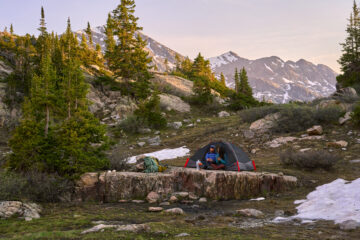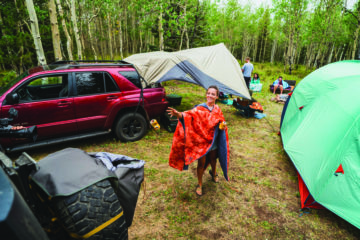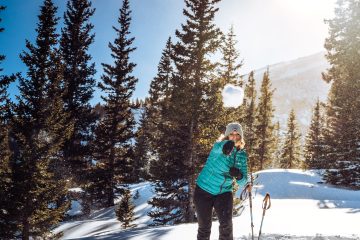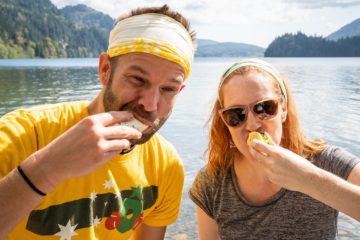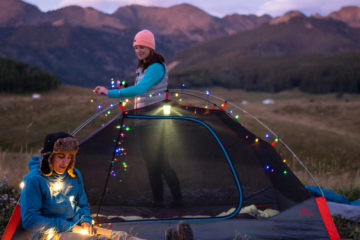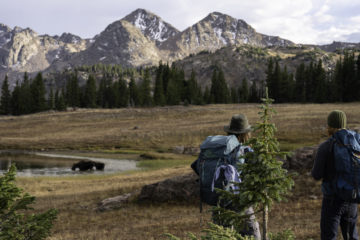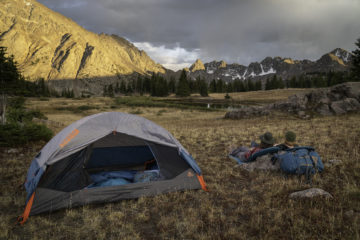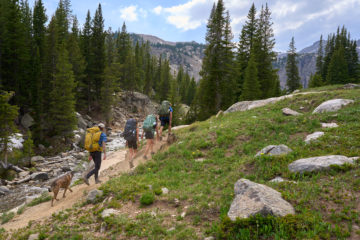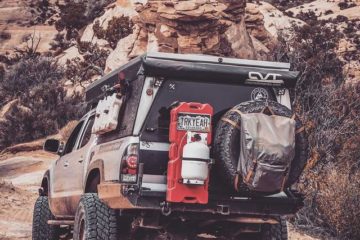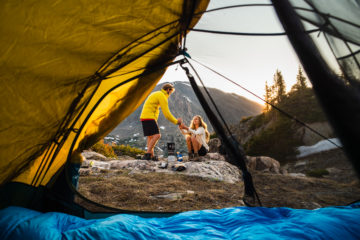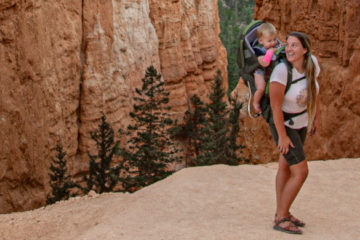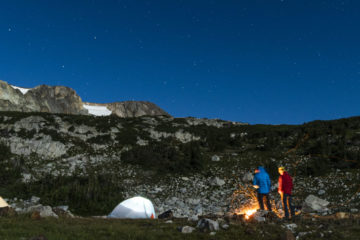
August 26 may be National Dog Day, but it’s just another Monday to us Kelytans; we basically worship at our dogs’ feet 24/7/365. Still, the so-called Dog Days of Summer are a perfectly good time to turn some focused attention to our canine companions—and what better way to do that than to meet some good bois who are living their heckin’ bestest lives?
If you live for your time in the backcountry and have been wondering how to raise an adventure dog who loves hiking and camping as much as you do, then listen up! We asked our favorite adventure dog moms, Julie Schultz (@tuckerleo_da_huskies) and Ellen Dohen (@nelleandlouise) to teach us their wise, wise ways on the subject of camping with dogs, the best adventure dog gear—and the absolute coolest giveaway of the summer.
KELTY: First, is there any special background or training that dog moms or dads should have in order to be successful at adventure dog training?
JULIE: No special training or background necessary, but I think preparation and research is certainly in order! The key is understanding the dog you are bringing into your life—whether it be a puppy or adult, and what kind of training might work best for them as far as their energy level and personality.
ELLEN: I don’t think anyone needs a specific background to have an adventure dog. Anyone can get outside. What is important, is understanding your dog’s behavior and listening to it. Dogs communicate and tell us so much, and we miss it when we don’t know what we are looking for.
Our dogs should feel comfortable in the adventures we are taking with them, and if they aren’t, we should ask “what can I do to communicate with my dog that this is a safe environment to explore?” That might be shorter hikes for a while, or hikes with less people. Having a successful adventure dog doesn’t mean your dog is off leash or can scale massive walls. It means you’re both living your best life together.
KELTY: Is there an ideal age at which you like to start adventure dog training? Any exceptions?
JULIE: Training starts the day your puppy comes home! If you are hoping to have an off-leash hiker, you will be most successful if you start taking steps to train recall from day one. If you are bringing home an adult dog, their training can start day one as well! It is just as possible to train an older dog to be your perfect adventure companion as it is with a pup!
ELLEN: I used to train and socialize service dogs, and to me, the training isn’t AS important with adventure dogs. It’s the socialization. You want them to feel comfortable when you’re adventuring. A properly socialized dog will ignore all stimuli on hikes: other people, other dogs, prey, unusual sights, campers, umbrellas, etc. This is what you want. A dog that is so confident and comfortable that they don’t feel the need to react to anything. They are just happy to do their thing.
I recently got a puppy, and I started right away with her. Carry treats in a treat carrier and be ready to distract your dog from any stimuli back to the treat you’re holding. Listen to your dog. There is no perfect process or timeline to follow. If they are giving you signals of being uncomfortable or too distracted, take a step back and train in a different environment. For me, that was a city park.

KELTY: Can you tell us a little bit about your personal adventure dog training process? How much do you customize for each individual pooch?
ELLEN: For me, a love of adventuring came out through dog ownership, so I sometimes feel like we learned together and trained each other! I fell in love with hiking and getting outside shortly after getting my first dog, Tucker, who is a husky and just loves being outside.
Two things were apparent soon into our first few hikes together: I wanted him to be able to explore off leash where it is allowed, and be able to hike alongside other dogs and people with confidence. We were eager to start exploring new places and it was important to me that that Tucker be well socialized and reliable off leash, so we started working on both!
Living in Chicago at the time, we were taking frequent weekday trips to the Montrose Dog Beach which was big enough that it didn’t feel like a cramped dog park; perfect for socializing, recall training, and having a fun time! Being a husky, Tucker has his share of stubbornness, prey drive, and selective hearing. I tried training recall with a longline and treats, but distractions like other dogs and prey often got the best of him. The same goes for my husky mix, Leo, who I adopted at about a year old.
I decided for their safety and my own peace of mind to work with a trainer, and e-collar train them for recall shortly after bringing Leo home. We use balanced training with a mix of their e-collars and treats and both Tucker and Leo are now incredible and well-mannered trail dogs! We have developed a special bond as our little family, our “pack,” which makes adventuring together effortless.
JULIE: Every dog is different. And there is no one training method that will work for every single dog. For me, I use positive-only reinforcement training. I’ve seen dogs fail on this method and I’ve seen dogs succeed. It’s important to research training approaches to find what will work best for your dog, and to be patient with progress.
My newest dog, Louise, is a MUCH slower learner than my superstar Nelle. Nelle wants to please me so much that she will follow almost every command, no matter what. Nelle is allowed to be off leash almost everywhere we go that it is legal, because we trust each other. I don’t trust Louise yet, and that’s okay. It takes some dogs and their humans years to feel confident being off leash.

KELTY: What do you think is the most critical step in the adventure dog training process?
JULIE: I am not sure that there is one critical step, but more of an understanding that every dog is different, and no two experiences raising or training an adventure dog will ever be the same.
ELLEN: PATIENCE! I think people are so quick to push their dog along and force their dogs to do things they aren’t ready for. Don’t hike a fourteener when you first get your dog. Don’t go straight to a backpacking trip when you have no idea how your dog will react in a tent. Everything is new! Dogs are living in our world, and it is up to us to show them what is acceptable behavior, and what isn’t. That—and camping cuddles in a Kelty Loveseat Chair—are the most critical steps to having a great adventure dog.

KELTY: In your experience, what are the best adventure dog breeds—or is this even a fair question to ask?
JULIE: That is so hard! There are definitely breeds that excel at certain activities over others, but generally any breed or “shelter special” mutt with moderate-to-high energy will make a great adventure dog, large or small. Personally, I will always have huskies and northern breed mixes.
ELLEN: I think this is up to every person. If you’re a day hiker who does two-ish miles, don’t get a high-energy breed that needs eight+ miles a day. ANY dog can be an adventure dog. Just make sure you’re picking one for your lifestyle. Pugs might not do well on backpacking trips, due to their respiratory issues, in the same way huskies won’t do well sitting in the house all day. For me, I love silly mutts. Rescues forever!
KELTY: Did any of your dogs have physical limitations or unique personality quirks you had to overcome with training?
JULIE: Thankfully both Tucker and Leo have grown into pretty awesome adventure dogs and didn’t have much to hold them back. Tucker has developed mild car anxiety, which can make long road trips more stressful for him—but with some exercise and a little bit of CBD before long trips, he is a happy camper!
ELLEN: Yes. Always. With Nelle, we are constantly working on her prey drive. She is so hyper-focused on prey that it’s often hard to get her to “leave it”, but she has been improving each time we train. She’s very busy when we are camping, so I’ve been using the Kelty Bestie BFF Blanket as a bed for her. It’s large enough that she can move around, but she knows she has to stay on the blanket while we are all relaxing around the fire. It’s waterproof on the bottom, so when we are ready to head to the tent, I don’t have to worry about it being soaked and can use it at night for myself as well. It’s nice too because it stakes down, so It won’t blow away.
KELTY: Are there any special pieces of adventure dog gear* (seasonal or otherwise) you like to have along on your trips? Do any of your dogs have favorites?
JULIE: Our camping trips would not be complete without our Kelty Loveseats! In fact, we own two now, so that my boyfriend and I can each share one with the dogs. They are the perfect chair to enjoy camping with your pups! We also never go on an adventure without the dogs’ favorites, RUFF BARs, which are basically a Clif Bar for dogs, and their favorite toys are definitely Chuck-it balls. Other adventure dog gear essentials for the pups include food from Only Natural Pet, biothane collars and leashes, Rexspecs, & a rescue harness/first aid kit from Ruff Rescue Gear CO—which all fit perfectly in the Kelty Lil G!
ELLEN: SOOOOOOO many things:
- Sloppy Chops Co leashes and collars. These Biothane products are muck proof and water proof. Best adventure dog gear out there.. So easy to keep clean and long lasting.
- RuffWear dog sleeping bag. Lousie gets very cold at night, and loves to cuddle up in the RuffWear dog sleeping bag.
- Hurtta Weekend Warrior harnesses and Coats. Hurtta has the BEST dog coats and jackets on the market. Hands down. They have A great fit, and are very durable. Their harnesses are my new favorites!
- I second the motion on RUFF BARS. They’re high in protein for those longer hikes. A great snack option for your four-legged friends.
- Again, Kelty Loveseats. I will never have a different camping chair. Built for one person and one dog—what more do you need?
- Kelty Noah’s Tarp or Big Shady. Dogs can overheat SOOOOOO quick. If you’re in a hot climate, a shade structure is NEEDED to keep your dogs safe.

KELTY: Do you have a favorite adventure dog training “win” or “fail” to share?
JULIE: I have a lovely adventure dog training FAIL to share! Last fall, Ellen and I were hiking in Aspen, CO with one of our other friends, Stephanie, and her two dogs. This is a lesson in “always pay attention to where your dog goes.” We were hiking up the trail and I realized I had seen Leo stop to sniff something, but as I passed him I assumed he would be done in a second and trail along behind us. Well, I turned around and did not see him anywhere! I called out his name once, and then twice, and suddenly saw him appear back on the trail and begrudgingly walk towards us. I told him good boy for coming back and we kept hiking along.
A few minutes passed, and I thought I kept getting a whiff of…sh*t…HUMAN sh*t…I look down at Leo and realize he had completely smeared the side of his face and neck in HUMAN POOP that he must have found on the side of the trail! Fear not, I thought, as we were hiking to a lake, so I could just wash him off when we got there. As hikers passed us coming down, they let us know the lake was dried up…oh boy. I found a small creek and did the best I could to wash this disgusting mess out of his neck, collar, AND e-collar…and then he slept in my tent with me that night. Lesson learned—the hard way!
ELLEN: All of my adventure dog training fails were things I didn’t know were fails, at the time. I used to let Nelle do whatever she wanted when we hiked. I let her run up to other dogs, other people, chase wildlife—anything. And I didn’t see an issue with it. But that isn’t okay. Not everyone likes dogs, and not all dogs like dogs. It took me having a reactive dog that doesn’t like dogs running up to her to understand that My win is every day, my dogs are hiking happy! That smile is win enough for me.
KELTY: What’s the one thing that surprised you most about your journey as an adventure dog mom?
JULIE: I think one of the things that surprises me most and still surprises me is how much my dogs have brought adventure into my life, and made me learn about myself. I owe them everything!
ELLEN: I had never hiked before I got a dog. I went from 2,000 steps a day to 12,000 easily! What surprised me so much is what I did before a dog. WHAT THE HELL WAS I DOING WITH MY LIFE BEFORE I GOT A DOG? I had so much free time, but what was I doing? I honestly don’t know because there wasn’t much notable.
KELTY: What’s the most rewarding thing about being an adventure dog mom?
JULIE: I think one of the most rewarding things is knowing that through my dogs I am living a happier and more fulfilled life, while they are having an incredible life, too. Tucker & Leo give me the drive I need to get outside and explore, which just leaves me wanting more!
ELLEN: Independence. Happiness. My best friends.

Photos by @talesofvoyage of @tuckerleo_da_huskies and @nelleandlouise.
For more Built for Play fun, follow @keltybuilt on Facebook & Instagram.
